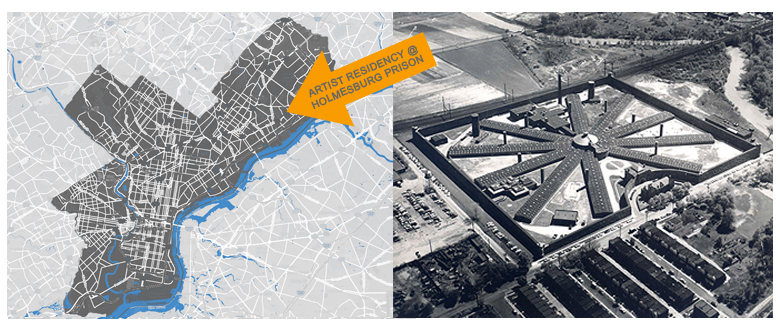
![]()
ABOUT
Doing Time | Depth of Surface
OPENING RECEPTION: Friday, January 27, 2012, 5:30-8pm
EXHIBITION RUN: January 28 – March 17, 2012
The Galleries at Moore College of Art & Design
20th St. & The Parkway, Philadelphia, PA 19103
Video documentation of Gomez and Gonzalez' artist residency at Holmesburg Prison
Spanish artists María Jesús González and Patricia Gómez have created large-scale prints, photographs and related videos during their artist residency at the now decommissioned Holmesburg Prison in Northeast Philadelphia. The artists, neither of whom
has exhibited previously in the U.S., have a collaborative practice grounded in art conservation; utilizing a modified version of a technique known as strappo, they work primarily to preserve the surfaces of buildings—the veritable “skin of architecture”—by detaching
a wall’s paint with glues and fabric and transferring that surface paint, in its entirety,
to a new canvas. In Philadelphia, they will work
at the now abandoned Holmesburg Prison
before it is demolished, creating large-format “printings” of drawings, paintings, and graffiti
left by former inmates on the walls.
The artists' prints are a physical archive of the prison cells—including paint, drawings and markings left by the inmates who lived there.
Holmesburg prison was built in 1896 following the widely replicated wheel and spoke plan designed by John Haviland for the Eastern State Penitentiary in 1829. It was in use for nearly a century, finally closing its doors in 1995.


How are these prints?
María Jesús González and Patricia Gómez on their process:
Coming from an experimental approach to printmaking, removing paint from a wall is, for us, an act of printing. What we obtain from this practice is considered a print: it is, however, a unique print, done outside the atelier, without a press, inks, or paper. The key concept here is that the wall is the matrix, functioning like a copper plate in chalcography (or a wood block in woodcut, or a stone in lithography). The wall is “marked” by accidents–through the passing of time and use–that create the image. These traces and accidents are the signature of time, representing social, historical, and sentimental information that could disappear.
For us, the definition of our work as “printing” is better justified by the concept behind printing than by technical or mechanical similarities, since the technique that we use is actually closer to mural removal.
How do you print the wind?
The artists first encountered experimental approaches to print-making when a professor of theirs challenged them
with this question.
The artists embraced this concept-based approach as they developed their unique technique to print architectural spaces. During their recent investigative trip to Philadelphia in June 2011, they explained how they came to their process in a conversation with the staff and volunteers working on the project.
The origin of our practice was an unexpected imprint when a piece of canvas detached from a wall. Instinctively, we thought of this as an act of printmaking, but with the intervention of different instruments and elements than we were using at the time. The matrix in our work became the walls; their surface (with several overlapping layers of paint, history and signs) imprinted by time and vital experiences. The supporting element that receives and registers the information is the canvas and the work of the press that completes the transfer by pressing together two surfaces is replaced by the process of fixing a canvas to the wall with glues and removing it later, once dried.
Holmesburg Prison
Holmesburg Prison is located off Torresdale Avenue in Northeast Philadelphia.
Please note: this site is not accessible to the public

